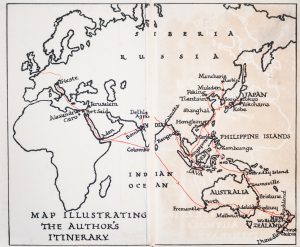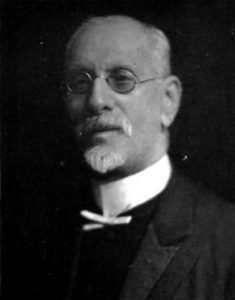By Sheree Trotter (This article was originally published on Times Of Israel.)
The Balfour Declaration has been exploited for political purposes by both supporters and opponents of the Jewish state. The following historical narrative situates the Balfour Declaration within the context of a small Jewish community at the ‘ends of the earth’, considers what it meant in its day and lessons for the present.

The 1917 Balfour Declaration was greeted with enthusiasm by the New Zealand Jewish community who believed it heralded a solution to the ‘Jewish Problem’.
The letter from Lord Balfour, British Foreign Secretary, to British Jewish leader, Lord Walter Rothschild, stated:
His Majesty’s Government view with favour the establishment in Palestine of a national home for the Jewish people, and will use their best endeavors to facilitate the achievement of this object, it being clearly understood that nothing shall be done which may prejudice the civil and religious rights of existing non-Jewish communities in Palestine or the rights and political status enjoyed by Jews in any other country.

Auckland’s Rabbi Goldstein, who served the community 1880-1935, hoped the declaration meant that, ‘Palestine the land hallowed by our history… …will yet be the smiling home of millions of Jews where they may live unfettered, unhampered and unpummelled with room for expansion, every life living the Jewish life with its distinctive religion, culture and aspirations’.¹
Goldstein envisaged a world where the Jewish people would no longer be ‘outcasts, but a recognised nation among nations’.
When the Balfour Declaration was endorsed at the San Remo conference in 1920, thus becoming part of international law, New Zealand Jewry held special services in their synagogues. The League of Nations then incorporated the declaration into the British Mandate for Palestine in 1922.
The declaration was highly significant, being the first official recognition by an international power of the aspirations of the Jewish people to a Jewish homeland. As such, it sparked a flurry of Zionist activity around the world.

A steady flow of Zionist emissaries made their way to New Zealand, seeking support for the ‘upbuilding of Palestine.’ The New Zealand Jewish community quickly gained a reputation for generosity in support of the cause. Enthusiasm for the Zionist project was not confined to the Jewish community however. The visiting Zionist leaders were well received in the general community as well.
Israel Cohen visited New Zealand in 1920 as part of a tour of the Jewish Communities of Australasia, India, and the Far East. It was the first journey of its kind. Cohen’s meetings in New Zealand were well subscribed, with over two thousand people, including the Prime Minister, Mayor and other dignitaries attending the event in the capital city of Wellington. Prime Minister William Massey gave a rousing speech in which he claimed scriptural support for the events in Israel. He believed that the capture of Jerusalem by General Allenby and British acceptance of the Palestine Mandate were significant steps towards the fulfilment of Bible prophecy.²
Government support for the Jewish people was not an anomaly. In 1891 the New Zealand Parliament, led by Sir George Grey, passed a resolution imploring the Russian Emperor to ameliorate the conditions of his Jewish subjects.
The petition stated:
We have learned with sorrow that that section of this ancient people who dwell within your Majesty’s vast dominions are subjected to exceptional disabilities and restrictions, and that numbers of them have been and are being expatriated from Russian soil, notwithstanding their loyalty as a people to your Majesty’s Throne and person, a loyalty which has often been sealed with their blood while fighting under the Imperial standard.³
New Zealand would later vote in favour of the United Nations Partition Plan for Palestine in 1947, which recommended the creation of independent Arab and Jewish states and a special international regime for the city of Jerusalem.
The Zionist movement, then as now, was far from monolithic. Rather it was multifaceted, with numerous internal debates and divisions within the wider discourse. There were political and practical Zionists, synthetic Zionists, cultural Zionists, territorialists, religious and secular Zionists, religious anti-Zionists, Labour Zionists and marxist/socialist anti-Zionists, and cosmopolitan anti-Zionists.
Historian Walter Laqueur, in referring to the many debates that occurred amongst Zionists stated, ‘The great majority were “instinctive Zionists” who needed no sophisticated ideological justification’.4 This may explain the fact that many Jews became involved in Zionist activities without adhering to a well developed ideology. New Zealand’s generous and ready response to the suffering of fellow Jews in less fortunate lands was built upon well established traditions of philanthropy and humanitarian activity.
Leading New Zealand Zionist of the period, Louis Phillips, explained:
It was the pressure of facts in other lands rather than in our own that created a theory of Zionism. With many Zionism was sensed as a panacea rather than as a spiritual and cultural revival. It was spun of the threads of pity and of philanthropy rather than of a creative national spirit struggling for expression. We thought of Zionism in terms of national relief rather than of national rebirth. Russian Jewry loomed large in our perspective, and the recital of the sufferings of our brethren in that benighted land moved us deeply. We realised that conditions there were fearful beyond words and we wished to mitigate them. Zionism would be an alleviant and that was its justification.5
New Zealand’s Jewish community never had to face the institutionalised discrimination of their British and European forbears. However, safety and relative prosperity combined with a perceived danger of assimilation to elevate concern over a potential loss of Jewish identity. Zionism provided a galvanising movement for many who had ‘wandered from the fold’. It was seen to bring together a disparate people and to offer, ‘new objects, new ambitions in life, a new lease of life’. Zionism rekindled a love for history, language and literature, and regenerated national interest.6
The enormity and horror of the Holocaust tends to eclipse the earlier history of Zionism. While a longing for “a return to Zion” had persisted for millennia, it was a confluence of historical circumstances beginning in the 19th century that enabled the Zionist movement to grow and flourish and, ultimately, for a Jewish state to become a reality. The movement took on an urgency as the twentieth century progressed. By 1948, the full extent of the Holocaust had became known and resistance to the establishment of a Jewish state could no longer prevail.
Sadly, the British support heralded by the Balfour Declaration a generation earlier had waned. The British actively opposed Jewish immigration to Palestine at a time when a homeland and sanctuary were most desperately needed. Had the Zionist dream been realized at an earlier date, millions of Jewish lives may have been saved.
The Balfour Declaration was but one step on a path that had been trod for millennia by Jews longing for a return to their ancient homeland. Although a tiny community at the ‘ends of the earth’, New Zealand Jews welcomed the Balfour Declaration and embraced the opportunity to contribute to the ‘upbuilding of Palestine’. The ominous thread of anti-Semitism that permeated the history of the Jews from the time of the expulsion from their ancient land to the beginnings of the Zionist movement in the 19th century and to the present, should not be forgotten. Although the Jewish people now have a state, the anti-Semitism that preceded and contributed to its formation has not disappeared. Rather it has morphed into modern and more insidious forms.
The centenary of the Balfour Declaration is an opportunity to pause and consider the lessons of history.
—
Footnotes
1.Goldstein Notes, Private Collection.
2. Evening Star , Issue 17450, 6 September 1920, Page 7.
3. Letter from Mr. Speaker to Lieut. General de Richter, Aide-de-camp to H.M. the Emperor of Russia, ‘Jewish Subjects of Russia’, Session 11, AJHR, 1891, New Zealand.
4. Walter Laqueur, A History of Zionism, New York, 2003, p.162.
5. Ben Green, ed., The New Zealand Jewish Review and Communal Directory 1931, Wellington, 1931.
6. Goldstein Notes, Private Collection.



